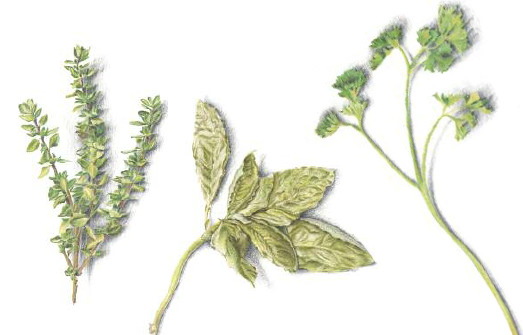edible garden
WINDOW GREENS
Harvest fresh seedlings this winter.
WRITTEN BY KAY FAHEY
Y ou see them at fine restaurants, those tiny sprigs of green, red, or purple plants that adorn a plate with spring freshness. They’re microgreens, very young plants that can pack a powerful flavor punch. And they are surprisingly easy to grow at home even in the depths of winter.
All you need is a sunny window, soil, and seeds. The most difficult part is choosing which greens to grow. Part of the charm of microgreens is that they come in a wide range of colors, textures, and tastes, from the pungent bite of ruby radish to the sweet fragrance of basil.
Common Microgreens: Arugula, Basil, Beets, Chives, Chicory, Cilantro, Cress, Endive, Kale, Lettuce, Mint Mustard, Mizuna, Peas, Pak choi, Radish, Shiso, Spinach, Tatsoi
Microgreens are tiny plants, usually from one to two inches tall, which include the stem and two true leaves. Almost any plant you would put in salads can be grown as microgreens. If you love assertive flavors, try red mustard and radicchio with green kale and turnip. For sweeter tones, plant red shiso, apple mint, pak choi, and butter cos lettuce.
Sprouts and microgreens are two distinct animals. Sprouts are germinated seeds, grown in water and low light. Microgreens are baby plants, grown in soil and sunlight.
Get started
First, choose your sunniest window. If you don’t have one, rig a grow light. Next you need a planter with sterile soil at least two inches deep and a drip tray beneath it. I use the light soil formulated for seed starting, which frequently contains a small amount of fertilizer. Get the soil damp, then scatter your seeds on top, 1/8 to ¼ inch apart. Sprinkle about 1/8 inch soil over the seeds. Now all you have to do is keep the soil from drying out and watch for the plants to appear.
You may want to cover your planter with clear plastic. Many planters come with such covers, which allow light to penetrate but keep in moisture and heat. Be sure the cover is at least two inches above the soil surface to prevent mold. As soon as the first seedlings poke up their heads (usually a week to 10 days), remove the cover to ensure good air circulation.
Because microgreens are harvested young they are seldom bothered by bugs or other problems. Your primary concern is to keep the soil moist. Most plants germinate at between 65 degrees F and 75 degrees F, so your soil needs to maintain this temperature for a while.
“You have to make sure it doesn’t get too hot,” warns Pawl Hollis, owner of Rail City Garden Center in Sparks. “Most houses are typically too warm.”
Once your seedlings put out two true leaves, snip them off close to the soil surface and start experimenting. Use your microgreens in salads and stir fries, serve them with cheeses and to accent appetizers or sprinkle atop soups and sandwiches.
Once harvested, your little plants will not grow anymore. However, you can reseed the soil and have a new crop in a few weeks. You don’t even need to remove the roots, just scratch the soil a little and start over.
Freelance writer Kay Fahey fills her wintertime windows with sweet basil, lime balm, and heirloom lettuce microgreens.
Flower Tree Nursery, 2975 Reno Hwy., Fallon, 775-423-1113, www.Flowertreenursery.com
Garden Shop Nursery, 3636 Mayberry Drive, Reno, 775-825-3527, www.Gardenshopnursery.com
Rail City Garden Center, 1720 Brierley Way, Sparks, 775-355-1551, www.Railcitygarden.com
Cook’s Garden, 800-457-9703, www.Cooksgarden.com
Seed Savers Exchange, 563-382-5990, www.Seedsavers.org
Seeds of Change, 888-762-7333, www.Seedsofchange.com
John Scheepers Kitchen Garden Seeds, 860-567-6086, www.Kitchengardenseeds.com


